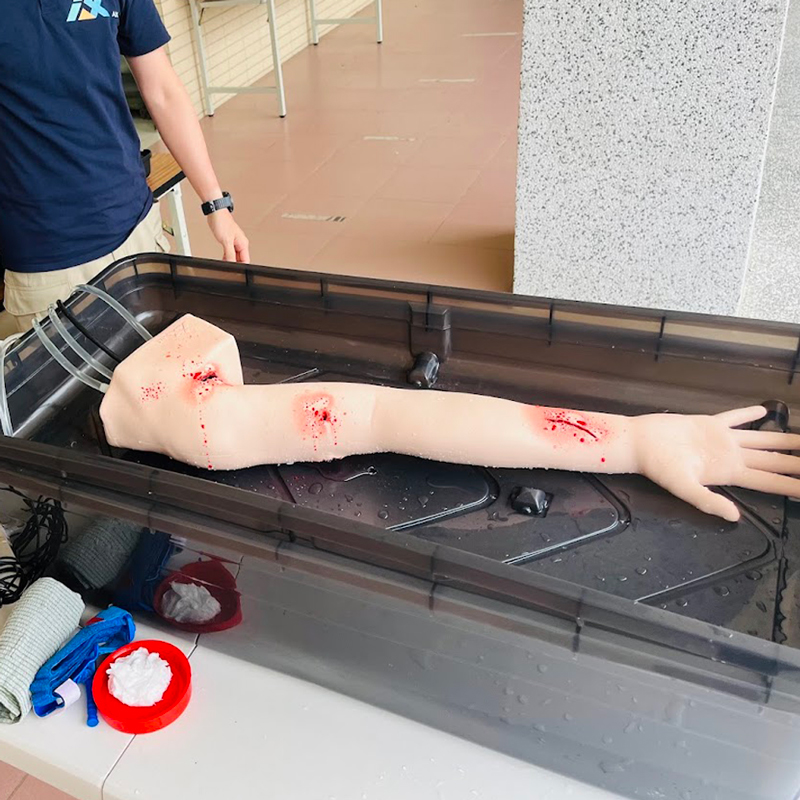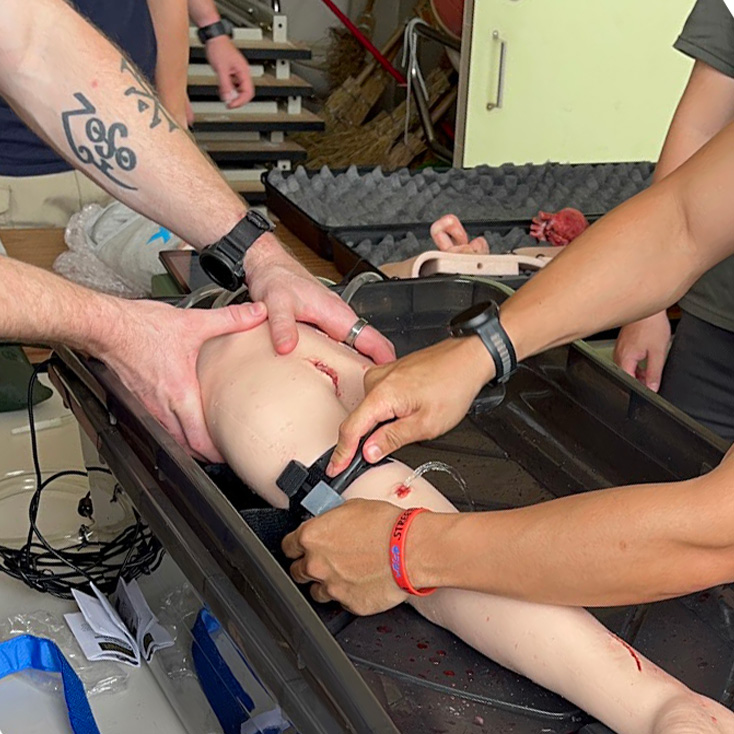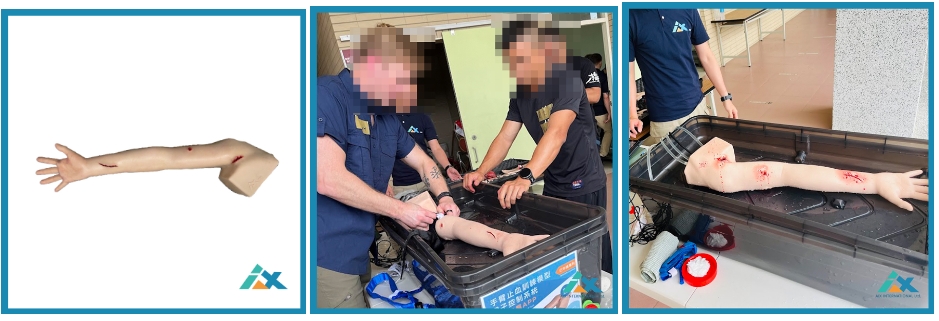How to Choose a Tourniquet ?
Different Brands on the MarketTourniquets are essential emergency tools used to control severe bleeding in limbs. Here are some major brands and their details:

Why Can a Tourniquet Stop Bleeding?
A tourniquet can stop bleeding primarily by compressing the arteries of a limb to prevent blood flow to the injury site, thereby reducing and controlling bleeding. Here are the specific mechanisms:
1. Compression of Blood Vessels:
When applied to a limb, the tourniquet generates sufficient pressure to compress the major arteries (such as the femoral or brachial artery). This effectively stops blood flow to the injury site. The pressure needs to be strong enough to fully block arterial blood flow but not so excessive as to cause tissue damage.
2.Preventing Massive Blood Loss:
In cases of limb injuries, especially when an artery is damaged, blood can flow out rapidly and in large volumes. By blocking arterial blood flow, the tourniquet reduces the amount of blood reaching the wound, preventing massive blood loss and giving the patient more time to receive professional medical treatment.
3.One-Handed Operation and Convenient Design:
Many modern tourniquets, such as the CAT (Combat Application Tourniquet), are designed for single-handed operation, making them convenient for use in emergency situations. This design allows rescuers or the injured person themselves to quickly and effectively apply the tourniquet.
4.Adjustable Pressure:
Tourniquets usually come with adjustable windlasses or buckles, allowing the user to adjust the pressure applied. This ensures that the blood flow is effectively blocked while minimizing the risk of limb damage.
5.Temporary Measure:
The use of a tourniquet is typically a temporary measure intended to buy time for the patient to receive professional medical care. Medical personnel will further assess and treat the wound once they arrive on the scene or when the patient reaches the hospital.

Different tourniquet brands
1. CAT (Combat Application Tourniquet)
- Features: The CAT tourniquet is made of durable nylon and features a single-hand operated windlass design, making it quick and effective to apply. It includes a built-in time tag to record the application time, crucial for medical personnel. The CAT tourniquet has been recognized as 100% effective by the U.S. Army and is considered one of the Army's top 10 greatest inventions.
- From: Made in the USA
- Link: https://www.narescue.com/combat-application-tourniquet-c-a-t.html
- Price: The CAT tourniquet is priced around $31-$35
2. SOF-T (Special Operations Forces Tactical Tourniquet)
- Features: The SOF-T tourniquet is designed for military and tactical use, featuring a high-strength metal windlass and textured grip for reliability in harsh environments. It can be quickly detached and reapplied, making it suitable for multiple uses.
- From: Made in the USA
- Link: https://tacmedsolutions.com/products/sof-tourniquet?variant=40626596544711
- Price: The SOF-T tourniquet is priced around $35-$40
3. SAM XT Tourniquet
- Features: Engineered for rapid application, SAM XT’s innovative design normalizes the number of windlass turns needed compared to traditional tourniquets, enabling an easier, faster training of the product and intuitive use. SAM XT’s TRUFORCE™ Buckle technology auto-locks at a predetermined amount of circumferential force, eliminating nearly all tourniquet slack. Simply click, twist, and secure for a life-preserving tourniquet application
- From: Made in the USA
- Link: https://www.sammedical.com/products/sam-xt-tourniquet
- Price: Priced at around $35-$40.
4. CET01-001
- Features: Can be used for severe bleeding in limbs or when a limb is severed, for emergency bleeding control at the injury site. In case of urgent bleeding, a bystander can assist in applying the tourniquet to provide first aid. This tourniquet is designed so that the injured person can use it to perform emergency care on their own, even without assistance from others, allowing for one-handed operation.
- From: Made in the Taiwan
- Link: https://www.emgtech.com.tw/product/21/68
- Price: Priced around $28-$33.

How to Use a Tourniquet: SOP (Standard Operating Procedure)
Using a tourniquet properly is crucial in emergency situations to control severe bleeding. Here is a step-by-step guide on how to apply a tourniquet:
- 1. Assess the Situation
Identify if the bleeding is life-threatening and if it is not controllable by direct pressure alone. Tourniquets should be used for severe limb bleeding or when a limb is severed. - 2. Position the Tourniquet
Place the tourniquet around the limb approximately 2-3 inches (5-7 cm) above the bleeding site. Do not place it directly over a joint (elbow or knee). -
3. Apply the Tourniquet
If using a windlass tourniquet (e.g., CAT tourniquet)
Pull the free end of the tourniquet strap tightly and secure it in place.
Twist the windlass rod until the bleeding stops. This may require several turns.
Secure the windlass rod in the windlass clip to prevent it from unwinding. - 4. Tighten and Secure
Ensure the tourniquet is tight enough to stop the bleeding. There should be no distal pulse (pulse beyond the tourniquet).
Secure any remaining strap end and ensure it does not loosen. - 5. Mark the Time
Write the time of application on the tourniquet or on the patient's skin. This information is crucial for medical personnel to know how long the tourniquet has been in place. - 6. Monitor and Reassess
-Periodically check the tourniquet to ensure it remains tight and the bleeding is controlled.
-Do not remove or loosen the tourniquet until professional medical help is available. - Important Notes
-Single-Handed Application: In situations where the injured person must apply the tourniquet themselves, such as when alone or without assistance, the tourniquet should be designed for single-handed use. Follow the same steps, ensuring you can apply and tighten the tourniquet using one hand.
-Multiple Tourniquets: If the first tourniquet does not stop the bleeding, a second tourniquet can be applied just above the first one.
-Seek Professional Help: Even after the tourniquet is applied, it is essential to get professional medical help as soon as possible.
How to Practice Using a Tourniquet
Wound simulation training holds significant importance in emergency response and medical training. Here are several key reasons explaining its importance:
Arm Bleeding Control (three types of wounds)(link)

The Arm Bleeding Control training device features three different types of wounds: cuts, punctures, and lacerations. Each wound type allows for practicing different bleeding control techniques: applying pressure, using a tourniquet, and packing the wound.
The design of the Arm Bleeding Control device makes bleeding control training more challenging than stopping bleeding on a real person. This is because everyone's body structure varies, requiring different amounts of pressure for effective control. Successfully stopping bleeding on this device indicates that the techniques will also be effective on real patients. Below are detailed data explanations.
Generally, in bleeding control training, narrower blood vessels are easier to control, and softer skin makes tourniquet application simpler. According to medical data, the average person's arterial blood vessel diameter ranges from 2.5 to 3.5 cm, while the Arm Bleeding Control device features blood vessels with a diameter of approximately 6 cm. Additionally, the softness of human skin typically measures 0.1 to 0.2 on the Shore A hardness scale, whereas the Arm Bleeding Control device's skin measures 20 on the Shore A hardness scale.
These design choices are why the Arm Bleeding Control device presents a higher difficulty level. By providing a more challenging training environment, trainees can develop stronger and more precise bleeding control skills. This ensures that once they master the techniques on this device, they will be well-prepared to apply them effectively in real-life scenarios.

The three wound types—cuts, punctures, and lacerations—each present unique challenges. Cuts require sustained direct pressure to control bleeding, punctures necessitate the use of tourniquets to stop arterial flow, and lacerations need thorough packing with gauze to ensure all bleeding points are controlled. By training on a device with enhanced difficulty, medical professionals and first responders can refine their techniques, improving their readiness and confidence in emergency situations.
In conclusion, the Arm Bleeding Control device is a comprehensive and rigorous training tool designed to prepare individuals for real-world emergency bleeding scenarios. Its challenging design ensures that those who can stop bleeding on this device will be more than capable of doing so on actual patients, thereby enhancing overall emergency response effectiveness.

More content

© rawpixel, 123RF Free Images
